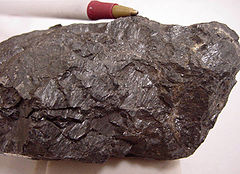Wurtzite
| Wurtzite | |
|---|---|
 |
|
| General | |
| Category | Sulfide mineral |
|
Formula (repeating unit) |
(Zn,Fe)S |
| Strunz classification | 2.CB.45 |
| Dana classification | 02.08.07.01 |
| Crystal system | Hexagonal |
| Crystal class | Dihexagonal pyramidal (6mm) H-M symbol: (6mm) |
| Space group | P63mc |
| Identification | |
| Color | Brownish black, Orange brown, Reddish brown, Black. |
| Crystal habit | Radial clusters and colloform crusts and masses. Also as tabular crystals |
| Cleavage | [1120] and [0001] |
| Fracture | Uneven - irregular |
| Mohs scale hardness | 3.5-4 |
| Luster | Resinous, brilliant submetallic on crystal faces |
| Streak | light brown |
| Diaphaneity | Translucent |
| Specific gravity | 4.09 measured, 4.10 calculated |
| Optical properties | Uniaxial (+) |
| Refractive index | nω = 2.356 nε = 2.378 |
| Birefringence | δ = 0.022 |
| Other characteristics | Nonmagnetic, non-radioactive |
| References | |
Wurtzite is a zinc iron sulfide mineral ((Zn,Fe)S) a less frequently encountered mineral form of sphalerite. The iron content is variable up to eight percent. It is trimorphous with matraite and sphalerite.
It occurs in hydrothermal deposits associated with sphalerite, pyrite, chalcopyrite, barite and marcasite. It also occurs in low-temperature clay-ironstone concretions.
It was first described in 1861 for an occurrence in the San José Mine, Oruro City, Cercado Province, Oruro Department, Bolivia, and named for French chemist Charles-Adolphe Wurtz. It has widespread distribution. In Europe it is reported from Příbram, Czech Republic; Hesse, Germany; and Liskeard, Cornwall, England. In the US it is reported from Litchfield County, Connecticut; Butte, Silver Bow County, Montana; at Frisco, Beaver County, Utah; and from the Joplin district, Jasper County, Missouri.
...
Wikipedia
